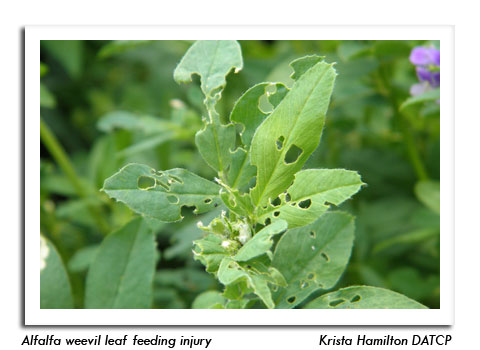
 |
|
|
Forages & Grains
Volume 58 Number 6 Date 06/06/2013 ALFALFA WEEVIL - Surveyed fields in the central and south-central areas contained populations of 0.1-9.2 first- to third-instar larvae per sweep, with an average of 2.4 per sweep. Larval infestations of consequence were confined to northeastern Jefferson and southeastern Dodge counties where leaf tip damage averaged 40% but ranged as high as 80%. Lower counts of 0.1-1.3 per sweep were observed in Columbia, Green Lake, Marquette, Waupaca and Waushara counties. Management plans at this time should include harvesting fields as soon as possible and monitoring new growth of the second crop for possible treatment needs. POTATO LEAFHOPPER - Migrant adult populations are still well below-threshold at 0.1-1.4 per sweep. The weekly high count was found near Rio in Columbia County. Reproduction has not been noted as of June 5. PEA APHID - Adults and nymphs are common in field collections in southern and central fields where counts vary from 0.5-11.4 per sweep. The average is about 3-4 per sweep. Counts of this level are considered non-economic in alfalfa, but aphid populations can escalate rapidly when natural enemy populations are disrupted by alfalfa weevil insecticide sprays. Harvesting fields on time rather than using insecticidal control is important for preserving natural enemies. PLANT BUG - Nymphs of the alfalfa plant bug are appearing in sweep net collections, in addition to the tarnished plant bug, which has been present in low numbers since late April. Populations increased markedly this week with the addition of the many small nymphs, but remain far below the 5.0 per plant economic threshold. GRASS SAWFLY - Low numbers of these pale yellow, striped larvae have been found in some alfalfa fields. The caterpillar-like worms are the immature form of the grass sawfly, an insect belonging to the bee and wasp order Hymenoptera. The larvae, which should not be mistaken for armyworms, are suspected of feeding on grasses and pose no threat to alfalfa. -- Krista Hamilton, DATCP Enotomologist 




|
|
|